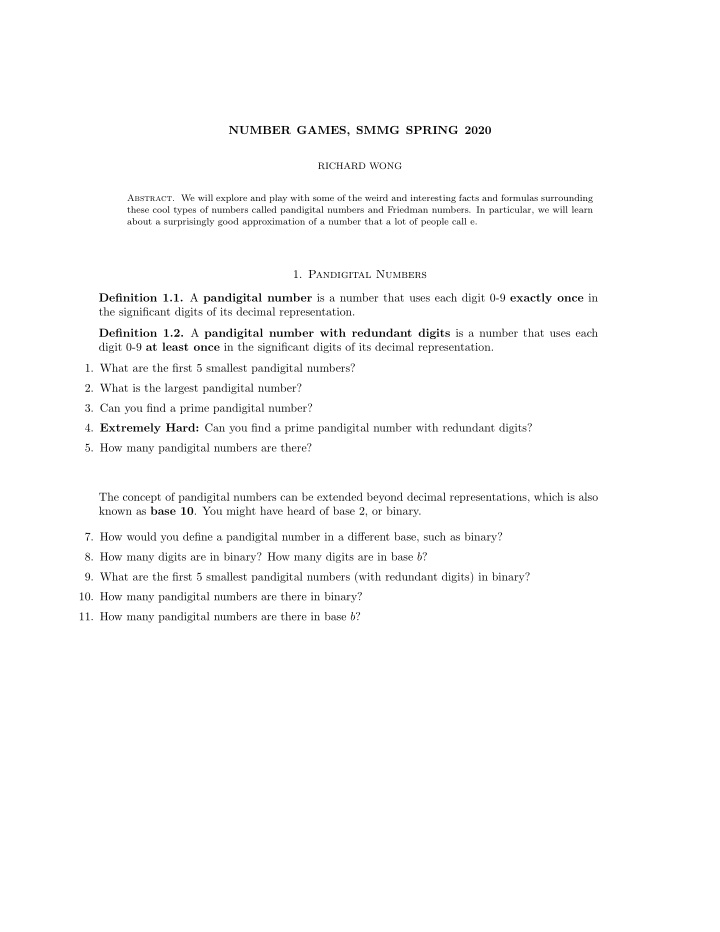



NUMBER GAMES, SMMG SPRING 2020 RICHARD WONG Abstract. We will explore and play with some of the weird and interesting facts and formulas surrounding these cool types of numbers called pandigital numbers and Friedman numbers. In particular, we will learn about a surprisingly good approximation of a number that a lot of people call e. 1. Pandigital Numbers Definition 1.1. A pandigital number is a number that uses each digit 0-9 exactly once in the significant digits of its decimal representation. Definition 1.2. A pandigital number with redundant digits is a number that uses each digit 0-9 at least once in the significant digits of its decimal representation. 1. What are the first 5 smallest pandigital numbers? 2. What is the largest pandigital number? 3. Can you find a prime pandigital number? 4. Extremely Hard: Can you find a prime pandigital number with redundant digits? 5. How many pandigital numbers are there? The concept of pandigital numbers can be extended beyond decimal representations, which is also known as base 10 . You might have heard of base 2, or binary. 7. How would you define a pandigital number in a different base, such as binary? 8. How many digits are in binary? How many digits are in base b ? 9. What are the first 5 smallest pandigital numbers (with redundant digits) in binary? 10. How many pandigital numbers are there in binary? 11. How many pandigital numbers are there in base b ?
2. Friedman Numbers Definition 2.1. A Friedman number is a number that can be non-trivially expressed as a formula using each of its significant digits exactly once, along with the operations (+ , − , × , ÷ ), additive inverses, parentheses, and exponentiation. 1. What is the smallest Friedman number? 2. Show that 121, 125, 126, 127, and 128 are Friedman numbers. 3. Hard: Prove that there is only one two-digit Friedman number. 4. Show that 1395 is a Friedman number. There are two different ways this is true! 5. BONUS: What can you say about Friedman numbers in base b ? To pass the time, you might want to play the 24 game . To play the game, you are given four numbers. The goal is to write the number 24 as a formula using each of those numbers exactly once, along with the operations (+ , − , × , ÷ ), and parentheses. You can play this with a deck of cards, but then you’re not always guaranteed a solution! A. 3, 4, 5, 5. B. 2, 2, 5, 7. C. 2, 4, 5, 11. D. 5, 5, 1, 12. E. 1, 3, 4, 6. Hard Challenge : Show there’s only one possible solution!
3. Approximating e . The number e is a mathematical constant that is used a lot of mathematics, including calculus, probability theory, and even calculating compound interest. It is an irrational, and even transcen- dental number, and is approximately e = 2 . 718281828459045 . . . Here are some formulas to approximate e : Try them out, and see how long it takes for them to get to within 5 significant digits of e . 1. As a sum: ∞ 1 � e = k ! k =0 2. As a limit: � n � 1 + 1 e = lim n n →∞ 3. As a continued fraction: 1 e = 2 + 1 1 + 2 2 + 3 3 + 4 4 + 5 + · · · 4. It is conjectured [RPM + 19] that the following continued fraction is equal to e , but this has not yet been proven! − 1 3 + − 2 4 + − 3 5 + − 4 6 + − 5 7 + 8 + · · · References [Cop14] Ed Copeland. Friedman Numbers - Numberphile, 2014. [Gri13] James Grime. Why 381,654,729 is awesome - Numberphile, 2013. [Gri16] James Grime. Incredible Formula - Numberphile, 2016. [RPM + 19] Gal Raayoni, George Pisha, Yahel Manor, Uri Mendlovic, Doron Haviv, Yaron Hadad, and Ido Kaminer. The ramanujan machine: Automatically generated conjectures on fundamental constants, 2019. Department of Mathematics, University of Texas at Austin, Austin, TX 78751 Current address : Department of Mathematics, University of Texas at Austin, Austin, TX 78751 E-mail address : richard.wong@math.utexas.edu
Recommend
More recommend